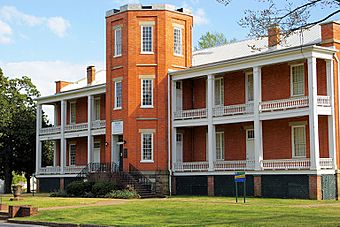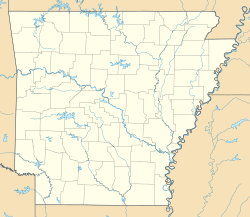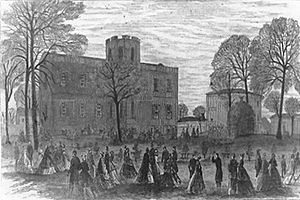Tower Building of the Little Rock Arsenal facts for kids
|
Tower Building of the Little Rock Arsenal
|
|
|
U.S. Historic district
Contributing property |
|

Main façade of the Tower Building
|
|
| Location | 503 E. 9th St., Little Rock, Arkansas |
|---|---|
| Built | 1841 |
| Architect | John Warmley Walker |
| Part of | MacArthur Park Historic District (ID77000269) |
| NRHP reference No. | 70000127 |
Quick facts for kids Significant dates |
|
| Added to NRHP | July 28, 1970 |
| Designated CP | July 25, 1977 |
The Tower Building of the Little Rock Arsenal is a historic building in Little Rock, Arkansas. It is now home to the MacArthur Museum of Arkansas Military History. This important building is also part of the MacArthur Park Historic District.
Built between 1840 and 1841, the Tower Building was once part of Little Rock's first U.S. military base. After it was no longer used by the military, it became home to two local museums. From 1942 to 1997, it housed the Arkansas Museum of Natural History and Antiquities. Since 2001, it has been the MacArthur Museum of Arkansas Military History. The building is famous for its unique eight-sided tower. It is the last original building from the old military base and one of the oldest buildings in central Arkansas.
This building is also special because it was the birthplace of General Douglas MacArthur. He became a very important commander of U.S. forces in the South Pacific during World War II. The building was also the starting point for the Camden Expedition during the American Civil War.
Contents
A Look at the Tower Building's Past
Early Uses of the Building and Park
The Tower Building and the park around it were used for many public events in the early 1900s. For example, in 1911, it was the main meeting place for a large gathering of Civil War veterans. Over 106,000 veterans attended, making it the biggest event in the city's history at that time. Many of them stayed in the building or camped in the park.
Later, the building served as a storage place for weapons for the Arkansas National Guard. In 1912, the second floor became Little Rock's first public library. In 1936, a new art museum, now called the Arkansas Arts Center, was built nearby.
The arsenal was added to the National Register of Historic Places in 1970. This list recognizes important historical places in the United States.
Becoming a Museum and MacArthur Park
In 1942, the Tower Building was fixed up and became the new home for the Arkansas Museum of Natural History and Antiquities. This museum stayed there for about 55 years. The park around the building was first called Arsenal Park, then City Park. In 1942, it was renamed MacArthur Park to honor General Douglas MacArthur.
In 1997, the natural history museum joined with another museum to form the Arkansas Museum of Discovery. This new museum moved to a different location. Then, on May 19, 2001, the The MacArthur Museum of Arkansas Military History opened in the Tower Building. This museum teaches visitors about Arkansas's military history, protects the old building, and honors the soldiers who served the United States.
How the Arsenal Was Built
The arsenal was built because Governor James S. Conway wanted to protect people living on the frontier. He was also worried about possible conflicts with Native Americans moving through the state. Major Robert B. Lee of the U.S. Army chose 36 acres of land on the edge of Little Rock for the arsenal.
John Wormley Walker, a builder for the government, oversaw the construction. The Tower Building was the first permanent structure built, starting in 1840. It was designed to store ammunition, so its outside walls were very thick, about 3 feet (0.9 meters) thick! Even though it was planned to be made of stone, it was built with strong masonry instead.
The American Civil War and the Arsenal
For many years, the arsenal was just a storage place for weapons, with only a few soldiers. But in November 1860, as the American Civil War was about to begin, more soldiers were sent to Little Rock.
In January 1861, Arkansas Governor Henry M. Rector told Captain James Totten, the federal commander, that the state wanted control of the arsenal. Captain Totten tried to get more soldiers, but none came. By February 5, about 1,000 local militia (citizen soldiers) had gathered in Little Rock.
Governor Rector then formally demanded that Captain Totten surrender the arsenal. Totten agreed, but only if his soldiers could leave safely and with honor. On February 8, 1861, the arsenal was handed over to state officials.
After the state took control, they found over 10,000 weapons and lots of ammunition inside. Most of these weapons were older models. Many of these arms were later used by Arkansas soldiers fighting for the Confederacy.
In 1862, much of the arsenal's equipment was moved away. However, Major General Thomas C. Hindman later restarted some operations at the Little Rock Arsenal. They began making ammunition and repairing weapons again. They even used old state library documents to make paper for cartridges because materials were so scarce!
This work continued until August 1863. Then, as Union troops advanced, the arsenal's supplies were packed up and sent away. Little Rock was surrendered to the Union Army on September 11, 1863.
In 1864, after the Union Army took control of Little Rock and the arsenal, General Frederick Steele led 8,500 troops from the arsenal. This was the start of the Camden Expedition.
Changes and Decommissioning
In 1873, the arsenal was renamed Little Rock Barracks. The main building was changed to be used as homes for married officers. Before this, the only entrance was a back basement door, and the tower was used to lift ammunition between floors. After 1868, porches, inside walls, and stairs were added. General Douglas MacArthur was born in this building in 1880, when his father was stationed there.
In the 1880s, the government decided to close many small arsenals. The Little Rock site was closed by October 1, 1890. In 1893, the Tower Building and the land around it were given to the city of Little Rock. The city promised to use the land "forever exclusively devoted to the uses and purposes of a public park." All the other original buildings around the Tower Building were torn down.
The Æsthetic Club's Role
In 1894, the Little Rock Æsthetic Club, one of the oldest women's groups west of the Mississippi River, moved into the Tower Building. They needed a larger meeting place. The club helped raise money to furnish the Arkansas Building at the Chicago World's Fair in 1893. After the fair, items from the exhibit were displayed in the Tower Building, and the Æsthetic Club was invited to meet there.
For almost 50 years, the Tower Building was mostly empty, except for the Æsthetic Club meetings. The building started to fall apart. The Æsthetic Club provided important financial help during this time, even paying the electric bill during the Great Depression. The Æsthetic Club still meets in the Tower Building today.
MacArthur Museum of Arkansas Military History
The MacArthur Museum of Arkansas Military History is located in the Tower Building. It is named after General Douglas MacArthur, who was born there. The museum opened in May 2001. It tells the stories of Arkansas soldiers from the Civil War through the Vietnam War. Visitors can see artifacts, photographs, weapons, and other items. One part of the museum focuses on the Battle of Little Rock.
More to Explore
- Bayou Fourche Battlefield
- David O. Dodd
- Old State House Museum




